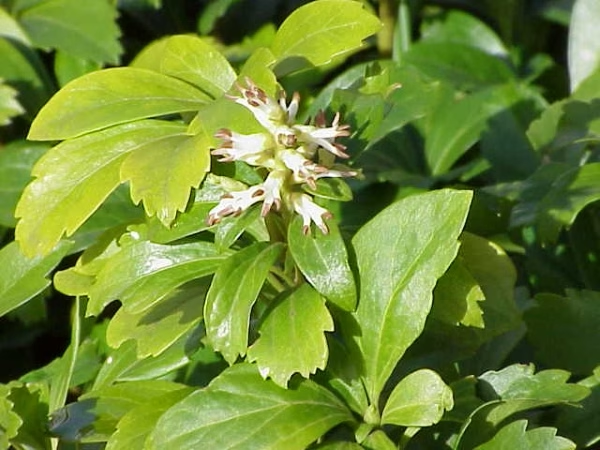
Japanese Pachysandra
Botanical Name
:
Pachysandra terminalis
Plant Type
:
Evergreen, herbaceous perennial ground cover.
Seasons
:
Year-round, active growth and flowering in early spring.
Sun Level
:
Partial shade to full shade. Intolerant of full sun as it causes foliage bleaching.
Ideal Soil Temperature for Planting
:
50°F–70°F (10°C–21°C)
Soil Type
:
Moist, well-drained, rich in organic matter; tolerates clay, sandy, and loam soils.
Germination
:
Best propagated by division or cuttings; slow to grow from seed.
P.H. Level
:
Slightly acidic to neutral (5.5–7.0)
Water/Irrigation
:
Keep soil consistently moist, especially during development. Once matured, it is moderately drought-tolerant.
Fertilization
:
Not necessary unless using organic fertilizers to maintain soil richness.
Habit
:
Forms dense mats via underground runners and spreading stems.
Final Plant Height
:
6–12 inches (15–30 cm)
Spread
:
12–24 inches (30–60 cm)
Spacing
:
6–12 inches apart for dense coverage
Flowers
:
Small, white, spiky flowers in early to mid-spring.
Attracts
:
Pollinators for its flowers but primarily valued for its attractive evergreen foliage.
Uses
:
Ground cover, erosion control, woodland gardens, underplanting for trees and shrubs.
Companions
:
Hostas, ferns, astilbes, bleeding hearts, hellebores
Pruning
:
Remove dead or damaged leaves occasionally for aesthetic purposes. Thinning may be necessary if leaf blight occurs to improve air circulation around plants.
Toxicity
:
Mildly toxic to pets and humans if ingested (causes stomach discomfort)
Pests
:
Occasionally affected by scale insects and slugs.
Diseases
:
Susceptible to leaf blight (Volutella blight) in humid conditions.
Additional Info
:
The leaves of Japanese Pachysandra contain saponins, which help deter browsing from deer and rabbits.
Botanical Name
:
Pachysandra terminalis
Plant Type
:
Evergreen, herbaceous perennial ground cover.
Seasons
:
Year-round, active growth and flowering in early spring.
Sun Level
:
Partial shade to full shade. Intolerant of full sun as it causes foliage bleaching.
Ideal Soil Temperature for Planting
:
50°F–70°F (10°C–21°C)
Soil Type
:
Moist, well-drained, rich in organic matter; tolerates clay, sandy, and loam soils.
Germination
:
Best propagated by division or cuttings; slow to grow from seed.
P.H. Level
:
Slightly acidic to neutral (5.5–7.0)
Water/Irrigation
:
Keep soil consistently moist, especially during development. Once matured, it is moderately drought-tolerant.
Fertilization
:
Not necessary unless using organic fertilizers to maintain soil richness.
Habit
:
Forms dense mats via underground runners and spreading stems.
Final Plant Height
:
6–12 inches (15–30 cm)
Spread
:
12–24 inches (30–60 cm)
Spacing
:
6–12 inches apart for dense coverage
Flowers
:
Small, white, spiky flowers in early to mid-spring.
Attracts
:
Pollinators for its flowers but primarily valued for its attractive evergreen foliage.
Uses
:
Ground cover, erosion control, woodland gardens, underplanting for trees and shrubs.
Companions
:
Hostas, ferns, astilbes, bleeding hearts, hellebores
Pruning
:
Remove dead or damaged leaves occasionally for aesthetic purposes. Thinning may be necessary if leaf blight occurs to improve air circulation around plants.
Toxicity
:
Mildly toxic to pets and humans if ingested (causes stomach discomfort)
Pests
:
Occasionally affected by scale insects and slugs.
Diseases
:
Susceptible to leaf blight (Volutella blight) in humid conditions.
Additional Info
:
The leaves of Japanese Pachysandra contain saponins, which help deter browsing from deer and rabbits.
Written by Salome Wapukha – https://www.linkedin.com/in/salome-wapukha-556700193/

